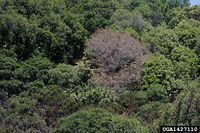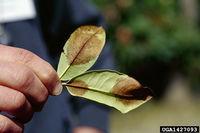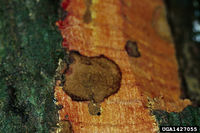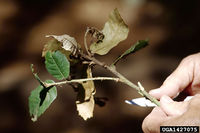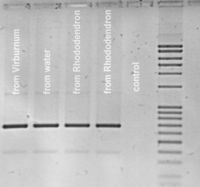Maintenance
All wikis at Biowikifarm are in read-only mode due to the restoration after a severe cyberattack in October 2023.
After 1 year being shut down the Biowikifarm is online again.
You see the latest restored version from 18th October 2023.
Phytophthora ramorum
| Literature database |
|---|
| 332 articles sorted by: |
| • year (descending) |
| • research topics |
| • countries/regions |
| • host plants |
| • list of antagonists |

Author(s): T. Jung, Y. Balci and A. Pérez-Sierra
Source: Persoonia 2018, vol. 40, p. 205
Phytophthora ramorum Werres et al., 2001 - (sudden oak death)
This oomycete causes important forest diseases in North America, like the lethal canker disease "sudden oak death". It infects mainly tanoak (Lithocarpus densiflora), coast live oak (Quercus agrifolia) and Californian black oak (Quercus kelloggii).
P. ramorum was discovered in the mid 1990s in California and has killed millions of trees. In 2005 more than 200,000 dead standing trees were found in the Big Sur region of California alone. It also causes sudden larch death in the U.K. as well as leaf blights (ramorum blight) and diebacks on various other plants, e.g. in Rhododendron.
It appears that P. ramorum is native to Europe and has been introduced into California, possibly via infected ornamentals. It then spread quickly through the costal forests of California and Oregon, causing stem canker as well as foliar and twig infections.
| Vernacular names | |
|---|---|
| • Deutsch: | plötzlicher Eichentod |
| • English: | sudden oak death sudden larch death ramorum blight |
| • Français: | mort subite du chêne |
Short distance transmission occurs by rain splashes through the air. The pathogen persists in leaf litter and plant debris. Long distance transmission involves the spread through rivers, transport of infected plant material, as well as contaminated footwear and vehicle tires.
Asexual reproduction involves the formation of 1) spindle-shaped sporangia, approximately 50 x 25 µm large, containing ~30 mobile zoospores, as well as 2) durable chlamydospores. Sexual reproduction and the formation of oospores is possible in the presence of the two mating types A1 and A2. In Europe, only A1 has been found with some rare exceptions, while both types occur in North America.
- Other images of Phytophthora ramorum (IPM Images and open Media - click to enlarge)
